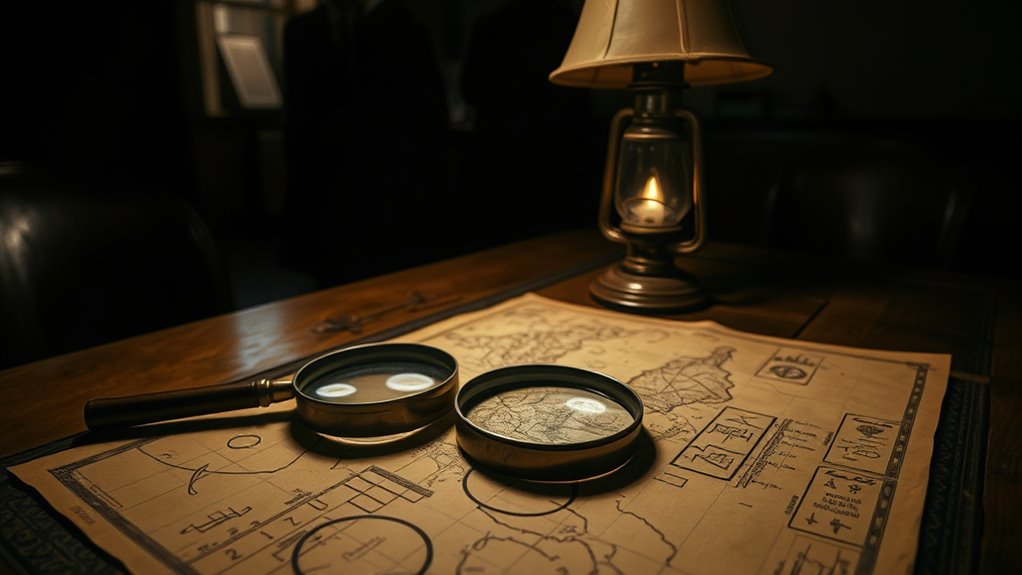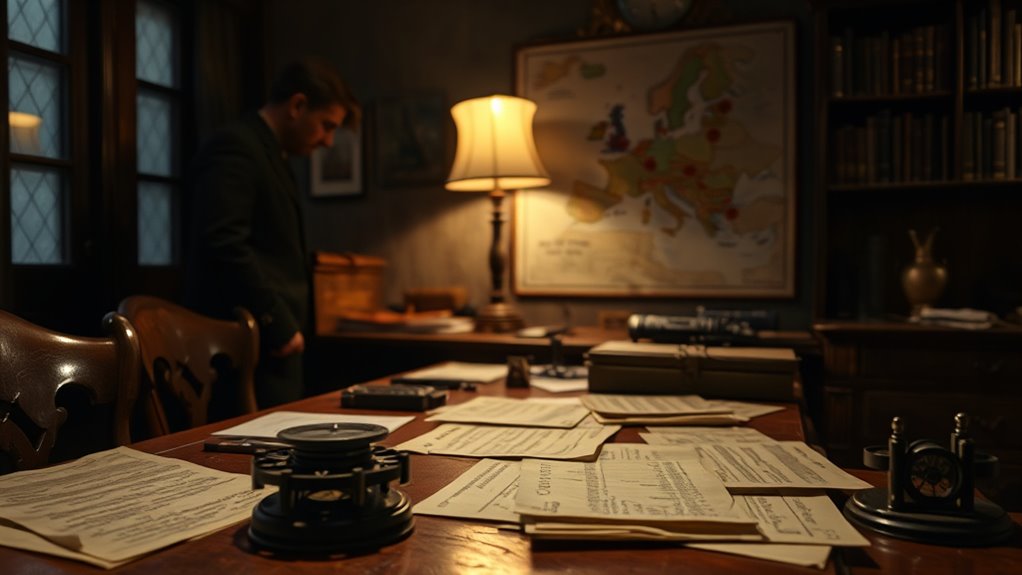The Zimmermann Telegram showcased early cryptographic techniques that paved the way for modern espionage influenced by artificial intelligence. British intelligence intercepted and decoded this essential communication, revealing Germany's plans and sparking outrage in the U.S. This event marked a shift in intelligence operations, highlighting the significance of collaboration between nations. The advancements in cryptology set the stage for contemporary intelligence frameworks and information manipulation strategies. There's much more to discover about this pivotal moment in history.
Key Takeaways
- The Zimmermann Telegram showcased early cryptology techniques that laid the foundation for modern encryption used in AI-driven espionage.
- British intelligence's success in decoding the telegram exemplified the strategic importance of information interception in warfare.
- The collaboration between British and American intelligence agencies post-Zimmermann established frameworks for sharing information, influencing contemporary AI espionage practices.
- Early espionage methods emphasized the manipulation of information, a tactic that has evolved into sophisticated AI algorithms used today.
- The legacy of the Zimmermann Telegram highlights the ongoing relevance of cryptology and intelligence in the context of technological advancements in espionage.
Overview of the Zimmermann Telegram

The Zimmermann Telegram stands as a pivotal moment in World War I history. Sent on January 16, 1917, by German Foreign Minister Arthur Zimmermann, it proposed a military alliance with Mexico against the United States.
The Zimmermann Telegram marked a critical turning point in World War I, revealing Germany's intentions and igniting American involvement.
In exchange, Germany promised to help Mexico regain territories like Texas, New Mexico, and Arizona. British intelligence intercepted and decoded this vital message, showcasing their mastery of German codes.
This intelligence success not only revealed Germany's aggressive intentions but also stirred public outrage in the U.S. when the telegram was made public on March 1, 1917.
The fallout ultimately contributed to America's decision to enter the war in April 1917, emphasizing how intelligence can dramatically shift the course of history.
About the Author: Thomas Boghardt

Thomas Boghardt's early life in Germany shapes his unique perspective on historical events.
As a senior historian at the U.S. Army Center of Military History and a former historian for the International Spy Museum, he brings a wealth of expertise to his analysis of the Zimmermann Telegram.
His research challenges established views, making his contributions crucial for understanding this pivotal moment in history.
Early Life Experiences
Growing up in Germany, Boghardt gained a unique perspective on the historical events surrounding the Zimmermann Telegram and World War I. This foundation shaped his understanding of intelligence and the intricate nature of diplomatic messages.
Living in multiple countries further enriched his grasp of international relations, revealing how past conflicts resonate today.
- Witnessing the impact of war on families
- Feeling the weight of historical narratives
- Understanding the complexities of loyalty and betrayal
- Recognizing the role of espionage in shaping outcomes
- Embracing the lessons of history to prevent future conflicts
These experiences fueled his passion for uncovering the layers of history, guiding his work as a historian in the field of military intelligence and espionage.
Professional Career Highlights
With a rich background in intelligence history, Boghardt has made significant contributions through his roles as a historian at the International Spy Museum and the U.S. Army Center of Military History.
His diverse cultural perspective, shaped by growing up in Germany and living in various countries, enhances his insights into military research.
At the International Spy Museum, he showcased his expertise, particularly in the area of espionage.
His research on the Zimmermann Telegram is notable for challenging traditional views and shedding new light on intelligence operations during World War I.
Currently residing in Bethesda, Maryland, with his family, Boghardt continues to blend his professional dedication with personal commitments, solidifying his impact on the field of intelligence history. Additionally, he recognizes the importance of seeking professional advice in navigating complex historical narratives.
Historical Expertise Focus
Having cultivated a rich understanding of intelligence history, Thomas Boghardt stands out as a leading authority in the field. His diverse cultural background enriches his insights, especially regarding the Zimmermann Telegram and its crucial role in shaping American diplomacy during World War I.
As a senior historian at the U.S. Army Center of Military History, he employs previously unavailable records to reveal profound truths about espionage.
- Unraveling secrets that changed the course of history
- Bridging cultures through the lens of intelligence
- Illuminating the delicate dance of diplomacy
- Capturing the essence of human intrigue
- Inspiring future generations to understand their past
Through his work, Boghardt not only educates but also evokes a sense of connection to our shared historical narrative.
The Role of British Intelligence Operations

British intelligence operations played an essential role in cracking the Zimmermann Telegram, thanks to the expertise of code-breakers like Nigel de Grey and Reginald Hall.
You'll see how their innovative techniques and strategic interception of communications helped shape the course of World War I.
This intelligence victory not only showcased their skills but also markedly swayed American public opinion.
Code-Breaking Techniques Employed
While steering through the complexities of wartime communications, British code-breakers in Room 40 of the Admiralty employed innovative techniques that would prove essential in decoding the Zimmermann Telegram.
Their mastery of code-breaking allowed them to intercept vital messages, revealing Germany's intentions.
- The thrill of uncovering secrets that could change the course of history.
- The weight of responsibility knowing lives hung in the balance.
- The rush of adrenaline as they cracked the German code.
- The fear of failure in a race against time.
- The pride in contributing to a significant military strategy.
British intelligence's swift actions not only showcased their expertise but also highlighted the Zimmermann Telegram's significant role in shaping American involvement in WWI.
Key Figures Involved
As the urgency of World War I escalated, key figures in British intelligence operations emerged as pivotal players in the interception of the Zimmermann Telegram.
Operating from Room 40 of the Admiralty, Nigel de Grey and Reginald Hall spearheaded the efforts to decode German communications. Their success in cracking the German code allowed British secret agents to grasp the telegram's content before it reached Mexico.
This intelligence triumph not only showcased British espionage effectiveness but also markedly swayed the U.S. decision to enter the war. In addition, British intelligence's monitoring of U.S. diplomatic traffic played an essential role in maintaining secrecy during the decoding process.
The operation set a precedent for future Anglo-American intelligence collaboration, reinforcing the strategic alliance between the two nations.
Impact on U.S. Involvement in World War I

The Zimmermann Telegram considerably influenced U.S. involvement in World War I, acting as a catalyst for a shift in public and governmental sentiment.
Once the telegram was leaked, it sparked outrage and prompted many to demand action against Germany.
- Imagine the fear of losing territories like Texas and Arizona.
- Picture the betrayal felt by Americans upon discovering Germany's intentions.
- Envision the rallying cries for justice echoing in towns and cities.
- Feel the urgency as the nation faced a direct threat.
- Consider how this moment marked a pivotal change in American foreign policy.
Ultimately, this telegram pushed the United States towards declaring war on the side of the Allies in April 1917 and solidified its role in global conflicts.
Intelligence Triumph and Techniques

Intercepting the Zimmermann Telegram marked a turning point in intelligence operations during World War I, showcasing how effective communication interception could shape international dynamics. British code-breakers from Room 40 demonstrated an intelligence triumph by cracking the German foreign office's codes. Their advanced cryptology techniques not only revealed Germany's secret plans but also set a precedent for future collaboration between British and American intelligence agencies. This event underscored the significance of intelligence in modern warfare and revolutionized military strategies.
| Technique | Description |
|---|---|
| Code-breaking | Decoding intercepted messages |
| Signal Interception | Monitoring enemy communications |
| Intelligence Sharing | Collaborating with allies for insights |
The success of the Zimmermann Telegram transformed espionage methods for generations to come.
The Legacy of the Zimmermann Telegram

Success in intercepting the Zimmermann Telegram didn't just change the course of World War I; it laid the groundwork for modern intelligence operations that are still relevant today.
Its impact resonates in various ways:
- It sparked a new era of cryptology and code-breaking.
- It fostered British-American intelligence cooperation essential in both World Wars.
- It led to the establishment of agencies like GCHQ and NSA.
- It demonstrated the power of information in shaping international relations.
- It provided lessons that informed strategies in World War II.
The legacy of the Zimmermann Telegram underscores how initial successes in espionage transformed the landscape of intelligence operations, ensuring that the art of deciphering codes remains critical in our security framework.
The Evolution of Espionage and Cryptology

As nations recognized the critical role of secure communication, espionage began to evolve dramatically in the wake of events like the Zimmermann Telegram. The interception and decoding by British code-breakers highlighted the importance of cryptology in shaping intelligence strategies. This marked a shift toward collaborative efforts between nations, particularly the UK and the US. Regular advancements in air purification technology have parallels in the development of cryptographic techniques, emphasizing the need for continuous improvement in both fields.
| Event | Significance | Impact on Modern Espionage |
|---|---|---|
| Zimmermann Telegram | Early cryptographic techniques | Paved the way for intelligence-sharing |
| British code-breaking | Major intelligence success | Enhanced international collaboration |
| Psychological warfare | Information manipulation | Foreshadowed AI-driven tactics |
| Cryptology advancements | Evolution of secure comms | Shaped modern intelligence frameworks |
This evolution continues to influence today's espionage methods.
Frequently Asked Questions
What Was the Coded Message of the Zimmerman Telegram?
The coded message of the Zimmermann Telegram proposed a military alliance between Germany and Mexico.
It offered Mexico the territories of Texas, New Mexico, and Arizona in exchange for their support against the United States.
Using a complex German cipher, the message remained concealed from its intended audience until British code-breakers intercepted and decoded it, revealing the startling proposal that ultimately swayed American public opinion and influenced the nation's entry into World War I.
How Was the British Government Able to Decode the Telegram?
The British government decoded the telegram by employing skilled code-breakers in Room 40. They'd cracked the German code used for communications, allowing them to intercept and analyze messages effectively.
With control over German telegraph cables, you'd see how they monitored enemy communications continuously. Key figures like Nigel de Grey and Reginald Hall played vital roles in this effort, ensuring the decoded information reached decision-makers, ultimately influencing public opinion and wartime strategies.
What Type of Code Was the Zimmermann Telegram?
When it comes to codes, you've got to remember that not all are created equal.
The Zimmermann Telegram used a diplomatic code, which was a system designed to cloak sensitive information. This code involved substituting words and phrases to disguise the true message.
British code-breakers, however, were sharp enough to crack it, revealing its secrets and altering the course of history.
Why Did Americans Feel Threatened by This Telegram?
You feel the tension rising as the Zimmermann Telegram reveals a potential alliance between Germany and Mexico against the United States.
This bold move threatens your nation's sovereignty and security, making you anxious about foreign intervention. The promise of reclaiming lost territories stirs up fears, igniting public outrage and anti-German sentiments.
With the telegram's authenticity confirmed, you're increasingly aware that America might've to abandon its isolationist stance to protect itself.
Conclusion
To summarize, the Zimmermann Telegram not only shifted the course of World War I but also marked a pivotal moment in intelligence history. With British cryptographers successfully decoding the message, they showcased the power of espionage. Notably, about 40% of U.S. military operations in the following years would rely on similar intelligence techniques, proving that the art of decoding and information gathering has shaped military strategies ever since. This legacy continues to influence modern espionage and AI applications today.








